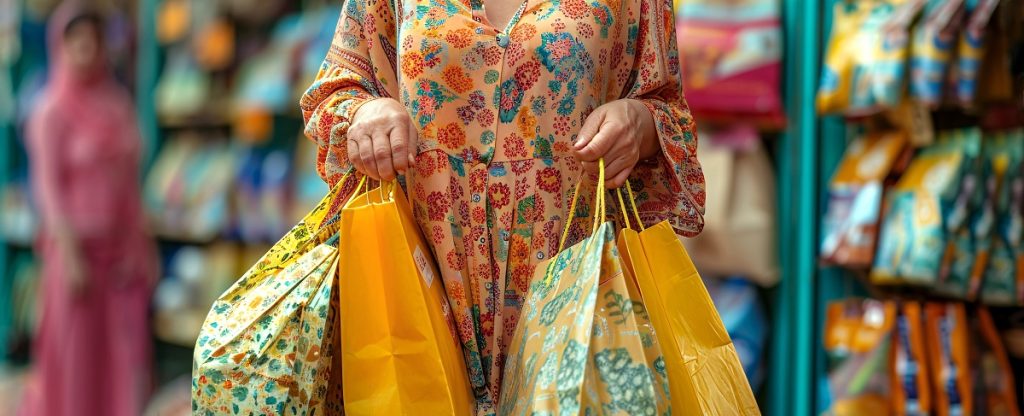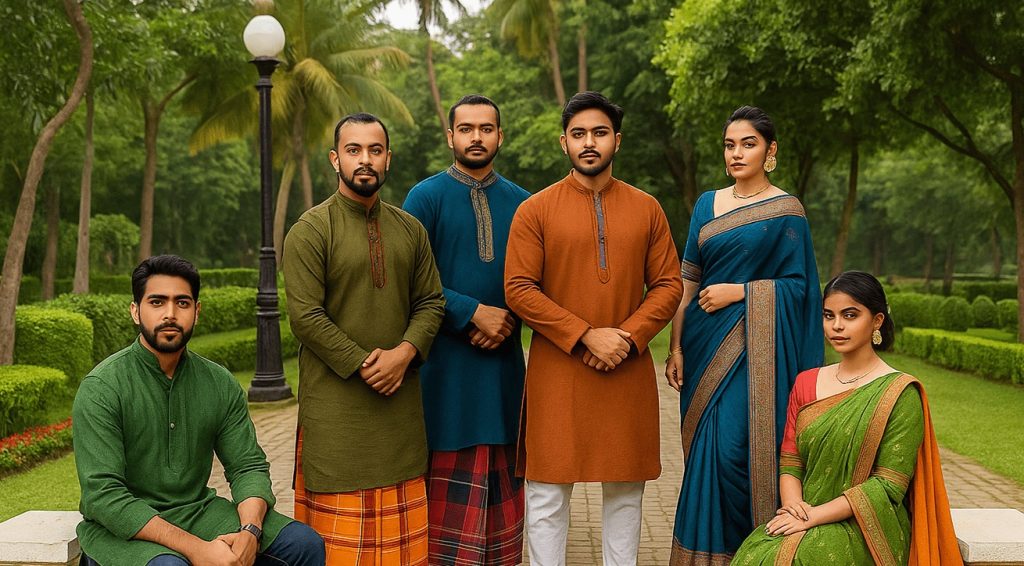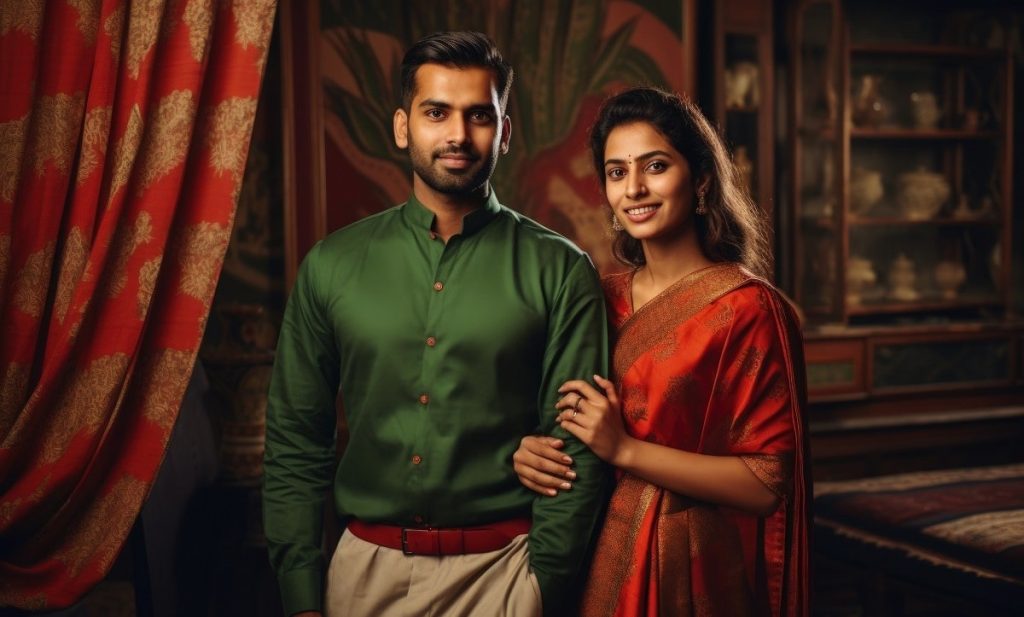What’s the first thing that comes to your mind when a festival is near? New clothes, right? In Bangladesh, no Eid, Puja, or Pohela Boishakh feels complete without that festive touch of fashion. In Bangladesh traditional dress isn’t just about looking good—it’s about celebrating who we are.
Think of the elegant sarees from Tangail, the dreamy Jamdani weaves, or the shiny Rajshahi silks—all carrying stories of our culture and pride. And now, with a modern twist, people mix these classics with trendy styles to make every outfit stand out.
So, ready to explore how fashion makes our festivals more colorful, joyful, and full of tradition? We bet you are!

Bangladeshi Traditional Dress: A Festival of Colors and Culture
In Bangladesh, festivals aren’t just celebrated—they’re worn. Every Eid, Puja, or Pohela Boishakh turns into a runway of colors, fabrics, and traditions. Clothing has always played a big part in how we celebrate, helping us express joy, respect, and togetherness.
A Bangladeshi traditional dress isn’t just fabric; it’s a reflection of our culture and pride. From the graceful Jamdani saree to the crisp cotton panjabi, each outfit carries the spirit of celebration in its threads.
But what makes it even more beautiful is how tradition meets the modern world. Today, young people mix heritage weaves with stylish cuts and fresh designs—creating looks that feel both rooted and new.
Whether it’s a Boishakh morning in red and white or an Eid evening in elegant silk, fashion brings our festivals to life. In every stitch, color, and pattern, we see a celebration of who we are—vibrant, proud, and uniquely Bangladeshi.
The Importance of Traditional Clothing in Festivals
In Bangladesh, outfits do more than just make us look good—they carry our culture, stories, and family traditions. Wearing a Bangladeshi traditional dress is a way to celebrate our roots while sharing joy with everyone around us. But why does it matter so much? Well, it starts with –
Preservation of Heritage
Traditional clothing in Bangladesh does more than just look beautiful—it keeps our heritage alive. Every weave, pattern, and fabric carries stories passed down through generations. In Bangladesh traditional clothing during festivals is a way to honor our ancestors and maintain the values, skills, and artistry that have been cherished for centuries. From the intricate Jamdani to the elegant Tangail saree, each piece connects us to a rich cultural past.
Cultural Significance
Festival outfits aren’t just about style—they hold deep cultural meaning. Certain colors, designs, and fabrics are tied to rituals, celebrations, and social customs. Red and white for Pohela Boishakh, green and gold for Eid, or specific patterns for weddings and Puja, all symbolize joy, prosperity, and unity. Traditional clothing strengthens social bonds, reminding us that festivals are a shared experience that brings communities together.
Intergenerational Influence
Elders play a key role in teaching younger generations how to dress for festivals. Grandparents and parents guide children in choosing outfits, combining colors, and wearing accessories correctly. This passing of knowledge ensures that the love and respect for traditional dress continues, making every festival a moment where culture, family, and fashion come together beautifully.
National Dress of Bangladesh

When it comes to celebrating festivals or daily life, every national dress of Bangladesh reflects both elegance and tradition. For men, the panjabi is the go-to outfit—simple, comfortable, yet dignified, perfect for prayers, family gatherings, or festive events.
Women often wear sarees, which combine grace with cultural richness, making them ideal for everything from Pohela Boishakh mornings to wedding celebrations. Together, these outfits define Bangladesh traditional clothing and showcase the country’s unique fashion heritage.
Colors and patterns in these outfits are never random—they carry deep meanings. Red and white sarees for Pohela Boishakh symbolize prosperity and new beginnings, while festive motifs and embroidered patterns often have religious or cultural significance. From subtle borders to intricate designs, every element tells a story and adds to the celebration’s charm.
Fabric and weaving techniques further elevate the beauty of the national dress. Jamdani, with its delicate handwoven patterns, Tant’s breathable cotton, and soft Muslin fabrics, all offer comfort while maintaining elegance.
Each one of the dresses represents a region’s history and craftsmanship, making festival attire not just stylish but also a tribute to Bangladeshi heritage. Wearing these traditional fabrics connects people to their roots while celebrating modern life with pride.
Regional Variations in Festival Attire
Bangladesh is a colorful tapestry of traditions, and festival clothing reflects this diversity beautifully. Each region brings its own style, fabrics, and flair, making the traditional clothing of Bangladesh a rich experience for both locals and visitors.
Dhaka’s Boutique Fashion & Urban Vibrance
In Dhaka, festival attire often mixes traditional fabrics with modern cuts. Boutiques offer vibrant sarees and stylish panjabis that blend heritage with contemporary trends. From bright colors to elegant patterns, Dhaka’s fashion scene gives festival dressing a cosmopolitan twist while keeping cultural roots intact.
Sylhet’s Traditional Style
Sylhet is known for its love of rich silk and handloom weaving. Sarees from this region often feature luxurious textures and intricate designs, making them perfect for festive celebrations. Men’s panjabis also reflect refined craftsmanship, emphasizing comfort alongside elegance.
Chittagong: Coastal Influence
In Chittagong, coastal life inspires festival clothing. Lightweight fabrics, bold colors, and breezy designs dominate both men’s and women’s outfits. Sarees and panjabis here are designed to keep you comfortable in humid weather while celebrating the festive spirit in style.
Northern & Tribal Influences
The northern regions like Rajshahi and Rangpur, along with the Chittagong Hill Tracts, showcase tribal and regional attire. Tribal sarees with unique motifs and handwoven fabrics, as well as distinctive male attire, highlight local craftsmanship and cultural identity. These regional variations make every festival a colorful reflection of Bangladesh’s diverse heritage.
Popular Festivals and Their Traditional Dress
Each festival in this country has its own iconic outfits that showcase the beauty of Bangladeshi traditional clothing. From vibrant colors to intricate designs, festival attire brings culture and joy to life.
Pohela Boishakh
Pohela Boishakh, the Bengali New Year, is a festival full of color and excitement. Women traditionally wear red-and-white sarees, symbolizing purity and new beginnings, often paired with floral jewelry or subtle embroidery.
Men typically wear festive panjabis in bright or contrasting colors, creating a cheerful and harmonious look for the day’s celebrations. The combination of traditional designs and lively patterns makes Pohela Boishakh a festival of both culture and fashion.
Durga Puja
Durga Puja is a time for elegance and cultural pride. Women wear sarees in rich fabrics, often featuring gold or silver borders, while colors like red, maroon, and orange dominate, symbolizing energy and devotion.
Men complement these festive looks with simple yet refined panjabis, highlighting the harmony between traditional attire and religious celebration. Every outfit reflects respect for heritage while adding a personal touch to the festivities.
Eid Celebrations
Eid is all about joy, togetherness, and looking your best. Women wear luxurious sarees in silk, chiffon, or georgette, often adorned with embroidery or modern motifs. Men choose panjabis in bright or pastel shades, sometimes paired with fusion wear that blends tradition and contemporary style. Eid attire emphasizes comfort, elegance, and celebration, making the festival a true feast for the eyes.
Modern Influences on Traditional Dress
Bangladesh traditional clothing isn’t stuck in the past—modern fashion trends are giving it a fresh, exciting twist. Today, festival attire blends heritage with new style, making traditional outfits more versatile, fun, and relevant for younger generations.
Fusion Wear and Global Trends
Fusion wear is taking the spotlight, combining Western cuts with local fabrics. Think panjabis with modern collars, sarees draped in new styles, or kurtas paired with trousers instead of pajamas. These innovations make Bangladesh traditional dress accessible, stylish, and comfortable, appealing to people who want to celebrate their culture while accepting global trends.
Young Designers Reviving Traditional Styles
Young designers are leading the way in reviving traditional patterns and weaves like Jamdani, Tangail, and Muslin, giving them a modern spin. By experimenting with colors, cuts, and combinations, they keep the essence of heritage alive while creating festival outfits that feel fresh and contemporary. Their work ensures that traditional clothing continues to evolve without losing its cultural roots.
Sustainable Fashion
Sustainability is also influencing modern festival fashion. Eco-friendly fabrics, handloom revival, and slow fashion approaches are becoming popular among both designers and consumers. Choosing breathable, natural fabrics not only honors traditional craftsmanship but also promotes environmental responsibility. This new wave of sustainable traditional clothing keeps festivals stylish, culturally rich, and eco-conscious all at once.
Bottom Line: The Future of Bangladeshi Traditional Clothing
Traditional attire in Bangladesh is more than just clothing—it reflects the nation’s rich heritage, culture, and identity. From the timeless elegance of Jamdani sarees to the classic panjabis, Bangladesh traditional dress carries stories of craftsmanship and generations of tradition.
Festivals and everyday life continue to celebrate these styles, keeping them vibrant and meaningful. At the same time, modern influences, young designers, and sustainable fashion trends are giving Bangladeshi traditional dress a fresh edge.
The future looks bright, as these iconic outfits gain global recognition while inspiring new generations to embrace and celebrate their cultural roots with pride.
